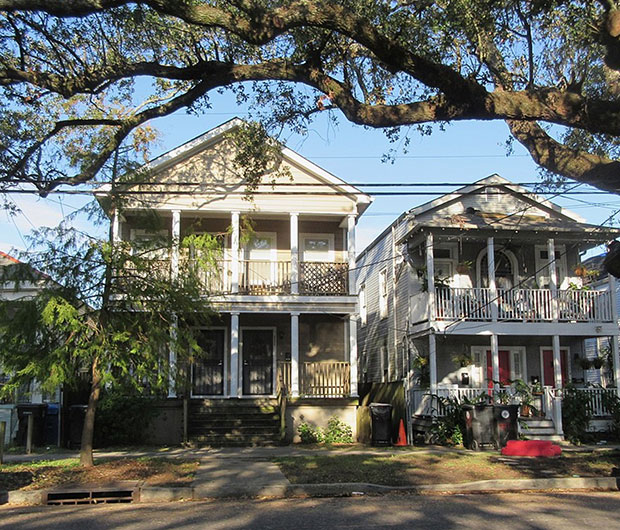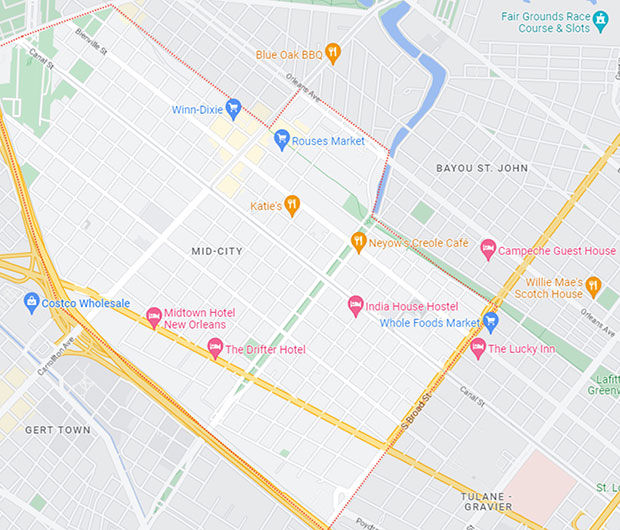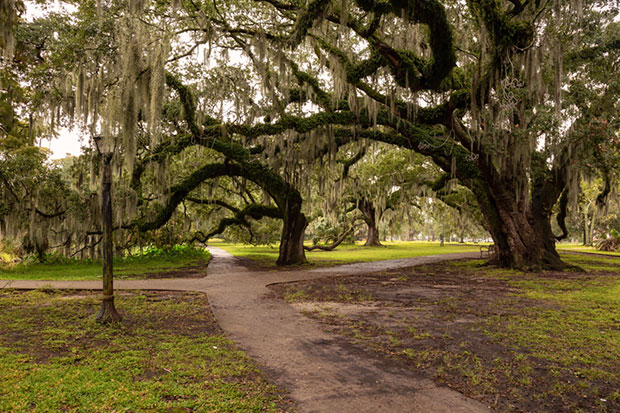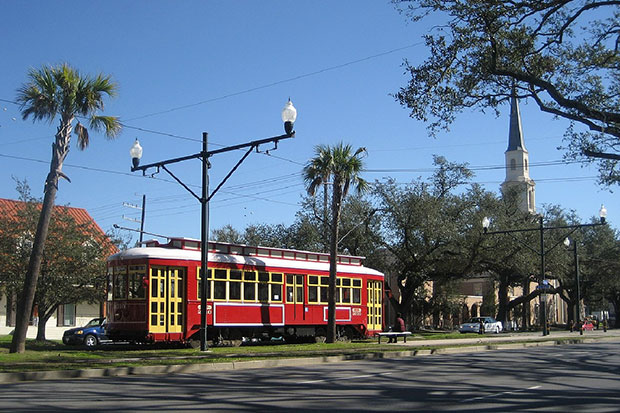Marigny Homes for Sale
Central location boasts of friendly, diverse neighbors and lots of beautiful scenery.
Mid-City has a lot to offer. With a booming new retail center centrally located on North Carrollton Avenue, living in this neighborhood means you’ll enjoy shopping and wining and dining in your own backyard. Highly walkable and filled with affable neighbors, this is the place for watching the sunset along the bayou with your dog, staying close enough to all the French Quarter action yet feeling like you have space for that veggie garden you intend to grow.


Where Is Mid-City?
Mid-City is a sub-district of the Mid-City District Area. According to the United States Census Bureau, it’s a total area of 1.66 square miles. Mid-City’s boundaries, as defined by the City Planning Commission, are:
The Marigny’s boundaries, as defined by the City Planning Commission, are:
North: City Park Avenue, Toulouse Street, North Carrollton Avenue, Orleans Avenue, Bayou St. John, and St. Louis Street
East: North Broad Street
West: Pontchartrain Expressway

Homes for Sale in Mid-City, New Orleans
Why Buy a Home in Mid-City?
This part of the city has so much to offer, from nightlife and eateries to greenery and accessibility Here are a few of our favorite things about Mid-City.
Easy Navigation. In a city where large swaths are easily reachable only by car, the ease of navigation from this area is a huge plus. You can access Mid-City by public transportation, bike, car, and even on foot from other areas of the city. Two streetcar lines run through the neighborhood, to City Park and the cluster of historic cemeteries at the end of Canal Street on the edge of Lakeview (with the streetcar extension project underway since summer 2017). The parallel thoroughfares of Canal Street and Tulane Avenue provide access to the interstate highway, which connects New Orleans with Metairie and Kenner, and is the primary route to Baton Rouge.
Recent Robust Development. New additions on North Carrollton Avenue include the Mid-City Market shopping center, which houses Panera Bread, Pinkberry, and Office Depot, and Marshall’s and Petco across the street. You’ll also enjoy easy access to several urgent care centers and popular chain restaurants such as Mr. Ed’s Oyster Bar & Fish House and Felipe’s Taqueria.
Incredibly Walkable. Walk Score rates the 70119 zip code as 73 out of 100, or very walkable and bikeable. It’s the sixth-most-walkable neighborhood in New Orleans. Today, the former St. Louis railway has been transformed into the Lafitte Greenway for walking and biking. The dog walkers stroll on the picturesque banks of Bayou St. John, and City Park is full of trails and walkways. The French Quarter is a 20-minute bike ride away, too. And the area’s major supermarkets — Rouses and Winn-Dixie — are easy to walk to, as are scores of the area’s restaurants, bars, and stores.
Home to Popular Festivals. Don’t forget the annual fun: Oktoberfest at Deutsches Haus’ new home at 1700 Moss St. and Bayou Boogaloo in May on the bayou, plus Voodoo Fest around Halloween in City Park. The park also throws a child-friendly Halloween celebration, Ghosts in the Oaks, and transforms after Thanksgiving into a magical holiday wonderland for Celebration in the Oaks. The spectacular Endymion, a superkrewe parade that rolls through Mid-City on the Saturday before Mardi Gras, has people staking their spots on the route days ahead.
Mid-City
Attractions
Aside from being the home of Mardi Gras’ largest parade, some of the city’s best bars and restaurants can be enjoyed in this neighborhood year-round. Below are but a few highlights we love.
Two Outdoor Treasures. You have more greenery to choose from in Mid-City, which is nestled between Bayou St. John and City Park. Take advantage of the lovely waters of the bayou for some kayaking and canoeing. Join the Mid-City Volleyball Group that sets up weekly courts on the bayou’s bank. At City Park, visit the Sculpture Garden, play mini golf, or rent a boat. You can also take your dog to the 4.6-acre dog park, or ride the antique wooden carousel at the amusement park on the park’s grounds.
“Need” a po-boy? One of the best in town is in the heart of Mid-City at Parkway Bakery and Tavern


Enjoy a craft beer at Second Line Brewing or Bayou Beer Garden. If wine is more your thing, hop over to a connecting patio of the Beer Garden’s sister establishment next door, Bayou Wine Garden
Stroll through the weekly Thursday farmer’s market at the American Can, then head to the wine tasting at Pearl, located in the building that’s adding a new patio and will soon host more businesses
Drink at Twelve Mile Limit, a neighborhood bar right in the middle of a residential area

History of Mid-City, New Orleans
As the name suggests, Mid-City is located in the middle of New Orleans, on the slope of the Mississippi River’s flood plain. The area was considered the back of town and wasn’t settled as early as the higher-elevated parts of the city such as Esplanade Ridge, which served as passageway between the old city and the bayous. Bayou St. John was used by the Chapitoulas and the Houmas tribes and European settlers as a shortcut to the river for centuries, and voodoo queen Marie Laveau was rumored to having performed rituals on the bayou’s banks.
The land that contained Allard Plantation, dating back to the late 1700s, was bought in 1845 by the philanthropist John McDonogh and willed to the city. It now hosts New Orleans City Park, a vast green expanse with a golf course, the New Orleans Botanical Garden, Sculpture Garden, Carousel Gardens Amusement Park, the New Orleans Museum of Art, and boating on the Big Lake.
New Orleans didn’t reach the lake but ended at the swamp until the late 19th century. Just like the rest of New Orleans, the area’s history depended on the development of a drainage system that would drain the low-lying swamps and make them habitable. The breakthrough came when engineer Albert Baldwin Wood invented the screw pump in 1913. Soon, the Mid-City basin was populated by a diverse mix of new immigrants and New Orleans residents escaping more congested areas.
Many new immigrants were from Sicily, and their influence is still felt strongly in the area, with long-standing institutions such as Mandina’s Restaurant and Angelo Brocato’s. The area is still one of the city’s most diverse, with a growing Hispanic influence and an eclectic mix of cultural influences from all over the world.
Mid-City was added to the National Register of Historic Places in 1993. A large area of Mid-City was given historic district status by the City Council in early 2017.
